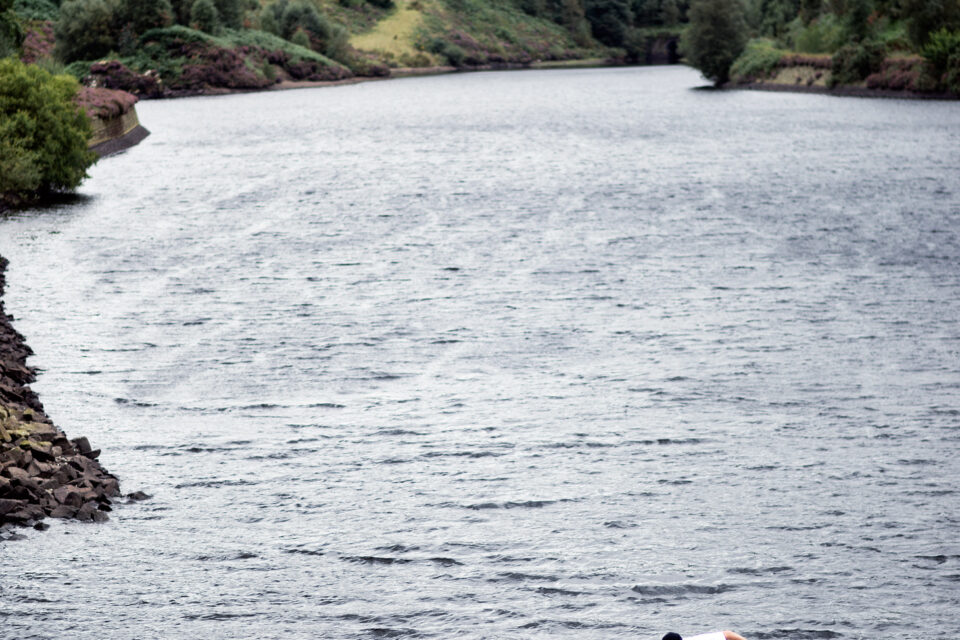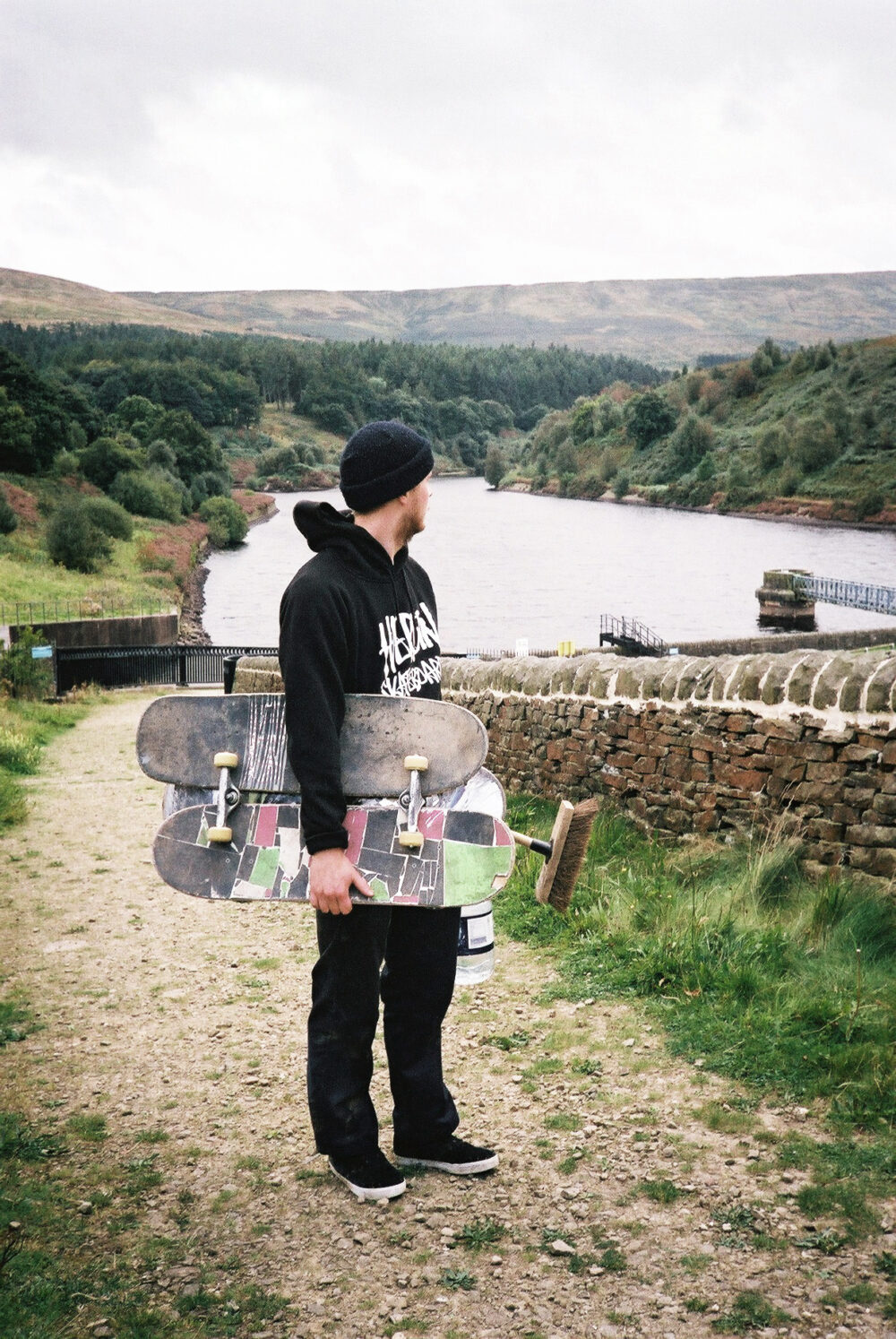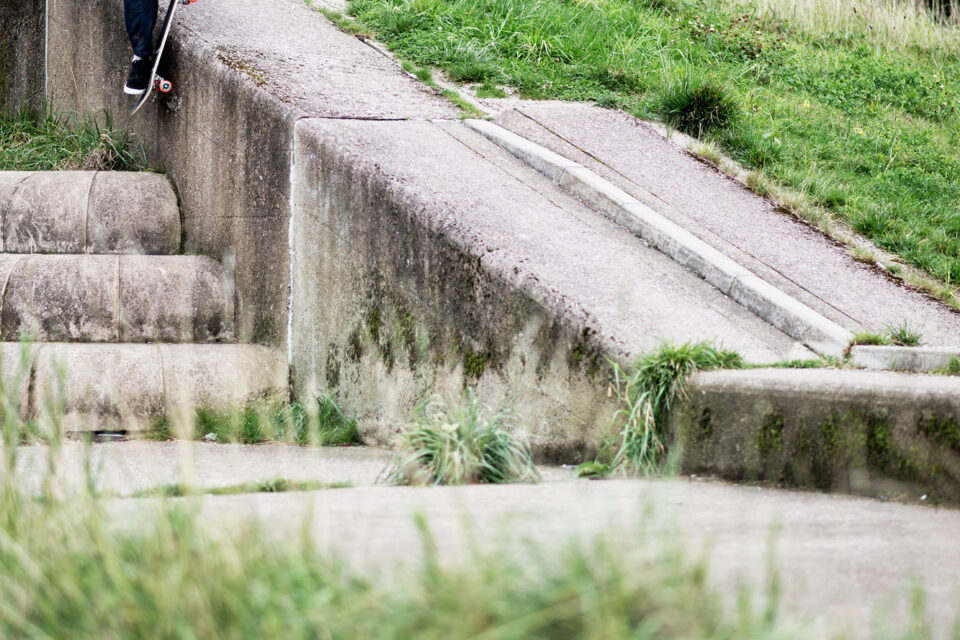Previous post


Interview and photography: Henry Kingsford
Tom, you moved from Manchester to rural Lincolnshire a couple of years ago, to live in – and renovate – a caravan near where you grew up. Now you’re back in Manchester. What’s happening with the place?
T – The place is still there. I spent two winters there, so going into the third winter I felt like I needed a little bit of a break from living out in the middle of the countryside. Jim and Pip (Jim’s girlfriend) and Joe (O’Donnell) were looking for a new house in Manchester, so I’ve come up here for this winter. I’ll probably start doing a bit more to that place in spring.
Are you still going back there much?
T – Yes, I have been. I’ve been going back every couple of weeks, but as it’s coming up to Christmas, I’ve sort of switched everything off down there and drained the water.
Can you describe your set-up out there?
T – It’s a three-acre field in the Fenlands of Lincolnshire. It’s quite flat and surrounded by farmland. I’ve got about a third of an acre fenced off and on there, there’s a 32-foot long static caravan that I’ve spent the last two years renovating and making a bit more liveable. I’ve been building some ramps outside the caravan, there’s an allotment dug out and I’ve got a few sheds and barns, a chicken house and a chicken coop with probably about a dozen chickens and ducks.
Who is looking after the animals at the moment?
T – It’s just down the road from my family so they go down there every day. They’re taking care of the chickens and stuff.
Tell us more about the skate obstacles.
T – When I was younger I was always building wooden ramps and ledges and things. Now, because I don’t have anywhere undercover, I wanted to try to build using concrete. A lot of it came down to the materials I could source. There was no concrete slab to start from, so I managed to find a bunch of paving slabs – I got given about 100 or so and I’ve been laying them. The idea really was to make something quite low-impact, small and fun with a more real street feel, so I used materials that would make a good noise and feel good when you’re skating them. There are a few quarters, but they’ve got pretty horrible coping that makes a good noise and I’ve built a BBC Banks replica with a metal manhole cover sunk in the middle. I wanted to make it so you can ride around or flow around a little bit, more like a racetrack rather than going back and forth.
Are you happy with how it’s turned out?
T – It’s slowly getting there. It’s still a bit awkward and there are a few things I want to change,
but I’ll slowly add to it and it will get a lot better, hopefully. The next few things I build are going
to be more like street spots. There’s a ledge going in and a few other things.
Onto Land – tell us about the project. It’s something you’ve both had in mind for a while, right?
T – Yes, it’s a project we’ve both been talking about for a while. We both grew up watching Death videos, and there would always be a spot that popped up in the middle of nowhere – you’d only see it that one time. We both wanted to hunt those spots down, so as we got older we looked into finding some of them. The next step was trying to document a bunch of those in one project.
J – We’ve always talked about it, but the timing was never quite right. There were always too many projects on the go, but at the start of this summer I’d just got back from being away for half the year and I had nothing on – I had a clean slate – so we focused solely on this for the rest of the summer. It was awesome.
So the idea came from seeing these sort of semi-mythical spots in Death videos?
J – Yes, that was the main way we saw them, in their videos and Big Push clips. Once we started trying to locate a few of those, we discovered that pretty much everyone knows about one sick rural spot – every time the topic was brought up in conversation, there would be a new nugget of information or a little clue as to where something was. Then we’d have to come home and spend six hours clicking around on Google Maps to track something down. I also started digging around on all these forums. It’s called ‘draining’ – ditches for draining overspills of reservoirs and stuff. If you look on these forums, you have all these dudes who go wandering through big, really fucking long drainage systems and they take pictures the whole way. It’s just like a spot book.
So these people aren’t skaters…
T – No, it’s more like urban exploration, but there’s kind of a subsection that involves going through drainage ditches and storm drains. We found quite a few of the spots trawling through these forums where people share places that they’ve found and explored.
In terms of inspiration for the film, was there anything in particular, aside from watching Death clips?
J – Not really. I just really like getting out of cities. I just really like the British countryside. I think it’s the best thing about Britain in general. I imagine you feel the same way, Tom.
T – Yes, it’s nice to get a break from just skating the main three spots in town. Going on those missions where you get in a car for two hours and you finally find what you’ve been looking for… You walk for half an hour through the woods to dig out a small bit of concrete so you can desperately try to get a trick to make the whole day worthwhile. It’s the whole mission of going there. You’ve got your packed lunch and your bottle of water and your shovel. Just the adventure of the whole thing…
I remember you guys telling me that you’d try really hard to get at least something at every location you made it to, no matter how unskateable.
T – I don’t know if it was a conscious decision, but if we’d managed to get the day off work together, got in the car and got to a spot on a dry day – or a dryish day anyway – we’d always manage to at least get something to make the whole mission worthwhile.
J – I think it’s worth mentioning that getting one trick involved driving for two hours or more one way, spending another hour digging out a spot and then actually cracking on and trying to skate it. To do all that and then to not film anything it would have felt like a bit of a cop-out.
What criteria did a location have to fulfil to be included?
J – I think we both wanted all the spots to be categorically rural. That was the only real criteria for the spots.
T – There are a couple of spots that are maybe closer to towns or are sort of part of a town, but where they’re located within that still looks rural. But a lot of the spots are out in Snowdonia, or in the complete wilderness. We just tried to get as much greenery in there as possible.
You mentioned an architect whose work kept popping up at different locations in the Peak District.
J – There was a firm that built a lot of the reservoirs up there, yes.
So you could see some recurring styles?
T – Yes, you definitely start to notice similar ways that the storm drains were built. Within the Peak District there must have been one firm that was contracted, or one architect who designed the drains in that area. After going to a few around the Peak District, we started to find a lot of similarities in the way they were constructed.
You’ve touched on this a little already, but run us through some of the practicalities of skating these spots in terms of the equipment needed to make them skateable and the work involved.
T – I had my van, so we had a shovel, two brushes and a heat lamp to attempt to dry the spot, like a blowtorch. That didn’t work as effectively as we thought it would, but it was quite good for getting weeds out of cracks. Once we started going to a few of these spots, we fell into a routine. It started to come quite naturally: one person would be digging the spot out, the other would be sweeping, trying to clear the spot as efficiently and as quickly as possible.
J – We learned from our mistakes as well. There was a day when we went up into the Peaks and we forgot to take any food or water. We were skating a spot and we all had a big fallout while Tom was trying a trick because we were all just so fucking hungry and thirsty. But we knew that if we left the spot, the nearest shop would have been an hour’s drive.
T – Maybe half an hour…
J – So we just had to suck it up.
T – It was at a point where we were following the overflow of this reservoir, so we were going further away from the car and finding more skateable spots up the hill. We had to try to skate the spots then. It would have been a nightmare to come back.
J – We had to learn from our mistakes with the practicalities of being out in those kinds of locations. Joe O’Donnell came on pretty much every single one of these missions, and Zach Riley came along quite a lot as well, so by the end we made quite a good little team. We all had a role.
What about some of the other challenges you faced. Water was a recurring theme wasn’t it?
T – I guess with it being summer, we expected a lot of these storm drains to be empty, but for the most part, there was always a trickle running through and it tended to be at the point where there was something quite interesting to skate. So quite a lot of the tricks were filmed with a wet run-up or run-out, which you can see in the footage.
J – I guess this goes with what we said before about trying to get something everywhere we went. When you drive for hours and you’re really excited but the spot’s got a wet run-out, you just have to make a conscious decision like: ‘Sorry Tom, you’re going to have to ruin your board.”
T – At the time, you convince yourself that it won’t be that slippery. You’ve made it here, you’ve found the place, you’re going to skate it, no matter how wet or dirty or damp it is.
The most extreme example of that was Belmont, where you skated in a few inches of water.
T –We’d both seen a photo of that spot a couple of years ago.
J – We only found out exactly where it was quite late in the summer and I think the reservoir’s water level was already too high. But we just desperately wanted to get something there because it looks so sick.
T – It was a shame because the best bit about that spot is a bank-to-block, but that was a foot under water, so there was no way you could skate it.
Were you anxious about being so isolated at any point? For example if Tom had got injured…
J – Yes, I definitely felt quite a lot of anxiety, especially when we had to hoist ourselves down some huge drop to get to a spot. If you to think about breaking your leg or something, the practicalities of getting out… it’s hardly worth thinking about. It definitely gave me a lot of anxiety. I don’t now about you, Tom.
T – I tried to blank that from my mind as much as possible. I’ve definitely had to drive home with a rolled ankle a number of times, but I tried not to think about anything worse than that, the idea of hitting your head up on a mountain in Snowdonia…
Which was your favourite location?
T – The Welsh Wallows, which is the spot at the end. We’d both been there once before. Rob from north Wales, he showed us the spot a few years ago. It’s one that we’d seen in a Death Big Push and Ricky Oyola was a guest on that trip, so knowing that he’d skated that spot was pretty rad. I guess that and being able to have a session at my house as well, having people come and stay and skate the stuff that I’ve built and camp out and barbecue for a few days – that was nice.
Was there anywhere you especially wanted to visit, but didn’t manage to get to?
J – Absolutely loads. I could make another edit twice as long and still not be done. There are spots all over the UK. Since we’ve stopped filming this one, I’ve been tracking down more. It’s almost like a habit now. I’m going on these fucking draining forums and just clicking around on Google Maps and finding more stuff already.
T – There was a lot of stuff that we’d already found and had sort of pencilled in for this one, but we just never… I guess British summer is so short, or so unreliable, that we weren’t able to get to a lot of them.
Do you see a second instalment at any time?
J – It’s something I’d happily do every summer. It’s such a cool thing to do. When the weather’s right, it’s such a nice… you know, skating in the city can get quite samey after a while.
T – You’re always going to hear about some new spot in the middle of nowhere and every time you hear about one, you want to chase that adventure, that kind of mythical spot.
J – There are spots are in Scotland, spots in Cornwall. Some of the rural spots you see popping up in edits, they’re incredible, but we literally couldn’t do half of them. But yes, I definitely want to do more of this. It’s really good fun.
Tell us about that guy who lives near the ditch near Northampton.
T – I’ve never actually met him. I’ve been to that ditch a couple of times now, but a few people from there have met him and know him a bit. I think he used to skate, or does skate, and when we went there, he’d left a shovel and brush outside his house. His house is right on the reservoir and the overspill runs around the whole perimeter of his house. He’s happy to let people skate the ditch next to his house. I think now and again he brings beers out for people. Apparently he might be a bit of a nudist. He invited someone to grab a beer from the fridge and that person walked around to find him in a G-string.
J – That’s one of the best spots.
T – Yes, it’s amazing.
Jim, tell us more about the edit. The film has a slower pace than lots of stuff you’ve made before.
J – I just wanted to keep it quite simple. I wanted the spots and the locations to speak for themselves, rather than trying to spice it up too much. I wanted to keep it at quite a slow pace. After I sent you the rough cut, you said it reminded you of that (Carhartt x Antiz) Swiss Banks clip, which stoked me out, because I absolutely loved that clip, the pace of it… I guess like you say it’s not really like anything I’ve ever done before. It’s a lot slower and a lot calmer. I wanted it to reflect the type of places we were. I didn’t want music that intruded too much on the atmosphere. You helped me out with that. We got some tracks from Matt Fowler’s band. I’m really stoked on the general feel of it.

